
What is piracy?
Hacking is the activity of identifying susceptibilities in a computer system or network to feat security and gain access to personal or commercial data. An instance of hacking could be: using a password cracking algorithm to access a computer system.
Computers have become a necessity to run a successful business. It is not enough to have remote computer systems; they need to be networked to enable announcement with external firms. This exposures them to the external world and piracy. System hacking means using computers to commit fake acts like fraud, invasion of privacy, theft of company / personal information, etc. Cybercrime costs many businesses millions of dollars each year. Companies need to protect themselves against these attacks.
In this hacking tutorial, we will learn:
Before we learn how to hack, let’s take a look at Introduction to Piracy and some of the most usually used terminologies in the world of piracy.
Who is a hacker?
A hacker is a person who finds liabilities in computer systems and networks and who can gain access through them. Hackers are usually skilled computer programmers with a background in computer safety.
Types of hackers
Hackers are confidential according to the intent of their actions. The following list categorizes the types of hackers based on their plan:
White Hat Hacker: Ethical hacker (White Hat): Security hacker who gains access to systems to fix identified vulnerabilities. You can also perform penetration tests and exposure analyzes.
Black Hat Hacker Cracker – A hacker who gains illegal access to computer systems for personal gain. The intent is usually to steal company data, violate privacy rights, transfer funds from bank accounts, etc.
Gray Hat Hacker-Gray Hat – A hacker who stands between ethical hackers and black hat hackers. It breaks into computer systems without authorization to identify weak points and reveal them to the owner of the system.
Script kiddies – An unqualified person who uses tools already created to gain access to computer systems.
Hacktivist – A hacker who uses hacking to send social, religious, political messages, etc. Usually, he does this by hijacking websites and leaving the news on the hijacked website.
Phreaker – A hacker who identifies and exploits vulnerabilities in phones, not computers.
Introduction of cybercrime
Cybercrime is when computers and networks used for illegal activities such as spreading computer viruses, online intimidation, unauthorized electronic transmissions, etc. Most cybercrime committed over the internet, and some cybercrime occurs online via mobile phones via SMS and SMS. . Chat applications.
Cybercrime type
The following list shows the most shared types of cybercrime:
Computer Fraud – Deliberate deception for personal gain through the use of computer systems.
Data Breach: Disclosure of personal information such as email addresses, phone numbers, account details, etc., on social media, hacking web site, etc.
Identity Theft – Theft someone’s personal information and impersonating that person.
Distribution of copyrighted files/information: This includes distributing copyrighted files such as e-books and computer programs etc.
Electronic money transfer: This includes unauthorized access to banking computer networks and illegal money transfers.
Electronic Money Laundering – This is where the computer used to launder money.
ATM Fraud – This includes the interception of ATM card information such as account numbers and PINs. These particulars then used to withdraw funds from the intercepted accounts.
Denial of Service Attacks – Computers are used in multiple locations to attack servers to shut them down.
Spam: sending unauthorized emails. These emails often contain advertisements.
What is ethical hacking?
Ethical hacking identifies weak spots in computer systems and computer networks and offers countermeasures to protect vulnerable areas. Ethical hackers must observe the following rules.
Before hacking, obtain written permission from the owner of the computer system and computer network.
Protect the privacy of the hacked company.
Report transparently to the organization all vulnerabilities identified in the computer system.
Inform hardware and software vendors of identified vulnerabilities.
Why Ethical Hacking?
Information is one of the most valued assets of a company. Keeping information secure can protect a company’s image and save you a lot of money.
Fake hacking can lead to business losses for financial companies like PayPal. Ethical hacking keeps them one step ahead of cybercriminals who would otherwise cause business losses.
Legality of ethical hacking
Ethical hacking is legal if the hacker adheres to the rules outlined in the honest hacking definition section above. The Global Council of Electronic Commerce Consultants (EC-Council) offers a certification program that assesses a person’s skills. Those who pass the exam receive certificates. Certificates need to renewed after a while.
Resume
Hacking is the identification and exploitation of vulnerabilities in computer systems and computer networks.
Cybercrime commits a crime with the help of computers and IT substructure.
Ethical hacking is about refining the security of computer systems and computer networks.
Ethical hacking is legal.
What is a security threat?
The security threat defined as a risk that can potentially harm computer systems and organizations. For example, the cause may be physical, the theft of a computer that contains important data. The reason can also be non-physical, such as a virus attack. In this tutorial series, we define a threat as a potential attack by a hacker that allows you to gain illegal access to a computer system.
What are physical threats?
A physical threat is a possible cause of an incident that could result in material loss or damage to computer systems.
The following list classifies physical threats into three (3) main categories;
Internal – threats are fire, unstable power supply, humidity in rooms with hardware, etc.
External – These threats include lightning, flood, earthquake, etc.
People: These threats include theft, infrastructure and hardware vandalism, malfunction, accidental or intentional failure.
To protect computer systems from the above physical threats, an organization must have physical security controls in residence.
The following list shows some of the likely actions that can take:
Internal: Fire hazards can prohibit by using fire alarms and automatic fire extinguishers that do not use water to extinguish a fire. The unbalanced power supply can prevent by using voltage regulators. The humidity in the computer room can controlled via an air conditioner.
External – Lightning protection systems can used to protect computer systems from such attacks. Lightning protection systems are not one hundred percent perfect, but they reduce the likelihood that lightning will cause damage in some cases. Hosting computer systems in the highlands is one of the ways to protect systems from flooding.
People: Threats like theft can be prevented by having closed doors and restricted access to computer rooms.










